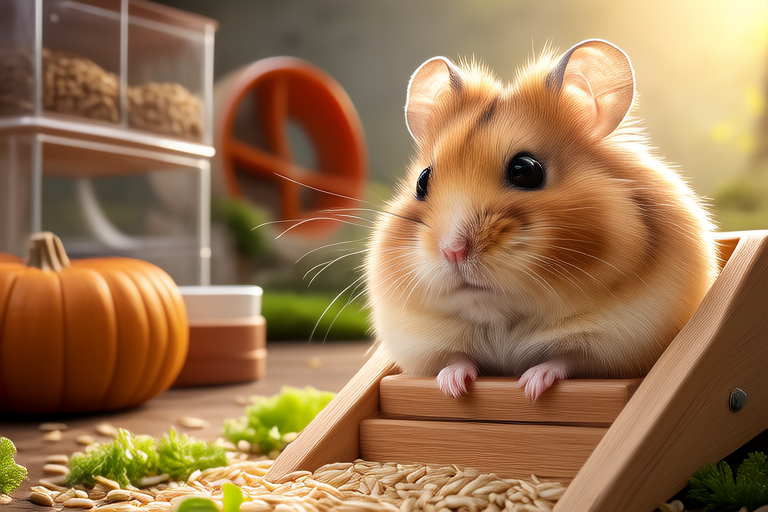Inside Look: A Day in the Life of a Golden Hamster
Welcome to a fascinating journey into the world of golden hamsters! These adorable creatures, native to Syria, have become popular pets worldwide. In this article, we will explore a typical day in the life of a golden hamster, detailing their waking hours, feeding times, play and exercise periods, sleep patterns, and more. By the end, you’ll have a deeper understanding of these delightful animals and their unique behaviors.
The Early Morning Stretches
Golden hamsters are nocturnal creatures, meaning they are most active during the night. However, their day begins with some early morning stretches. As the sun rises, your golden hamster will likely be just waking up from its long night of activity. You might notice them yawning widely, stretching their tiny bodies, and grooming themselves thoroughly. This grooming ritual is essential for hamsters, as it helps keep their fur clean and healthy.
After their initial wake-up routine, golden hamsters often engage in some light exploration of their habitat. They may nibble on some fresh bedding or check out new toys that have been added to their cage. This curiosity-driven behavior is part of what makes golden hamsters such engaging pets. They love to investigate their surroundings and can be quite inquisitive about new objects.
Feeding Time: Nutritious Delights
As the day progresses, it’s time for feeding. Golden hamsters have a varied diet that includes high-quality commercial hamster food, fresh vegetables, and occasional fruits. The best time to feed them is in the evening when they are most active. A balanced diet ensures that your hamster remains healthy and energetic throughout the night.
In addition to their regular meals, golden hamsters also enjoy treats like small pieces of apple, carrot, or broccoli. It’s important to offer these treats sparingly, as too many can lead to digestive issues. Providing a variety of foods keeps your hamster interested and satisfied. Watching your hamster eat can be a delightful experience; they often hoard extra food in their cheeks before storing it away in a designated area of their cage.
Playtime and Exercise: Keeping Fit and Happy
Physical activity is crucial for golden hamsters, helping them stay fit and mentally stimulated. During the day, while humans are typically at work or school, your hamster might spend some time exercising on an exercise wheel or playing with chew toys. These activities help wear down their sharp teeth, which grow continuously.
Golden hamsters are known for their impressive running abilities. An average-sized hamster can run several miles on a wheel each night! This level of activity requires a sturdy, non-slip surface to prevent injury. Additionally, providing a variety of toys and tunnels allows your hamster to explore and play, mimicking the natural burrowing behavior they would exhibit in the wild.
Exploring the Environment: Burrowing and Hiding
Burrowing is a fundamental behavior for golden hamsters. In the wild, they create extensive underground tunnels and chambers where they store food, sleep, and raise their young. While your pet hamster won’t dig deep burrows, they still enjoy having areas to hide and explore within their cage.
To accommodate this natural instinct, provide plenty of hiding spots such as tunnels, boxes, or specially designed hamster houses. Your hamster will appreciate having a cozy retreat where they can feel safe and secure. Watching them dart through tunnels or hide in their house can be entertaining and endearing.
Nighttime Vigilance: Active and Alert
As the sun sets and darkness falls, golden hamsters come alive. Their heightened senses make them well-suited for nighttime activities. They are highly alert and can detect even the slightest movements around them. This vigilance serves them well in the wild, where they need to be cautious of predators.
During their peak activity period, your hamster will engage in various behaviors. They may continue to run on their wheel, explore new areas of their cage, or interact with any companions if you have multiple hamsters. Their nocturnal nature means they are most active when humans are asleep, making them ideal pets for people who work during the day.
Sleeping Patterns: Restful Nights
Despite their nocturnal habits, golden hamsters still require ample rest. They spend a significant portion of their day sleeping, typically taking short naps throughout the day and longer periods of sleep during the night. On average, a golden hamster sleeps for about 14 hours a day.
Your hamster’s sleeping environment should be comfortable and quiet. Ensure that their cage is placed in a location free from drafts and excessive noise. Providing soft bedding materials like shredded paper or fleece can further enhance their comfort. Observing your hamster’s sleep patterns can be fascinating; they often curl up into a tight ball, with their nose tucked under their tail for warmth.
Cleaning and Hygiene: Maintaining Good Health
Keeping your golden hamster’s living space clean is vital for their health and happiness. Regular cleaning helps prevent the buildup of bacteria and odors. Aim to clean the cage every few days, removing soiled bedding and replacing it with fresh material. Spot cleaning between full cleanings ensures that your hamster’s environment remains pleasant.
Aside from maintaining a clean cage, providing your hamster with appropriate hygiene items is essential. A sand bath allows them to groom themselves and keep their fur clean. Unlike water baths, sand baths are preferred because they don’t cause water damage to the hamster’s delicate skin. Watch your hamster enjoy a dust bath; it’s a charming sight!
Interacting with Humans: Building Trust
While golden hamsters are primarily solitary creatures, they can develop strong bonds with their owners. Handling your hamster gently and consistently helps build trust. Start by allowing them to get used to your scent by placing your hand near their cage without trying to pick them up immediately.
Once your hamster feels comfortable around you, you can begin handling them. Always support their body fully when holding them and avoid sudden movements that could startle them. With patience and consistency, your hamster may learn to enjoy interaction with you. Some hamsters even become affectionate, seeking out human contact and enjoying gentle petting.
Conclusion: A Joyful Companion
A day in the life of a golden hamster is filled with activity, exploration, and rest. From their early morning stretches to their nighttime vigils, these small creatures lead rich and fulfilling lives. Understanding their needs and behaviors allows you to provide a happy and healthy environment for your pet.
If you’re considering getting a golden hamster as a pet, remember that they require attention to detail in terms of their diet, exercise, and habitat. With proper care, you’ll have a loyal and entertaining companion for years to come. Enjoy watching your golden hamster thrive in its new home!

